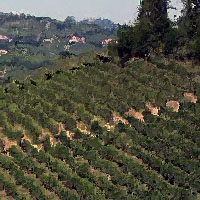Permanent cover for soil and water conservation in mechanized vineyards: A study case in Piedmont, NW Italy

HTML: 31
All claims expressed in this article are solely those of the authors and do not necessarily represent those of their affiliated organizations, or those of the publisher, the editors and the reviewers. Any product that may be evaluated in this article or claim that may be made by its manufacturer is not guaranteed or endorsed by the publisher.
Vineyards’ soils are especially threatened by the risk of soil compaction and soil erosion, with negative consequences for wine production and provisioning of ecosystem services. The adopted inter-rows soil management influences the response of vineyard to different types of rainfall events, in terms of runoff and soil erosion. Actually, the use of cover crops in vineyards is widely considered as an effective measure for conservation of water and soil. A 3-years study was carried out in Piedmont (NW Italy) to evaluate the effectiveness of grass cover as a soil water conservation measure, compared with tillage, and particularly the influence of different types of rainfall events and tractor traffic in determining hydrological and erosive response of the vineyard. During the investigation period (November 2016 - December 2019), climate variables, runoff, and soil losses were continuously monitored along with vineyard management operations. Very different yearly precipitation characterized the observed period, including the driest and wettest year in the last 20 years. Runoff and soil erosion caused by different types of rainfall events (long-lasting, intense and normal) in two vineyard’s plots managed with permanent grass cover and tillage, respectively, have been compared. In addition, the influence of the number of tractor traffic was taken into account. Runoff volume was principally affected by soil management, while sediment yield was influenced by the type of event. Both were higher in the tilled plot than in the grassed one, for all types of events, even if differences were not always significant. Grass cover reduced by 65% the runoff, with the highest efficiency during intense events. Soil losses were reduced on average by 72%, with 74% efficiency during the most erosive intense events and the lowest protection (56%) during long-lasting rainfall. Moreover, the response of grass cover plot was less influenced by traffication. The study demonstrates the efficiency of grass cover in reducing water and soil losses also during extreme events, that are predicted to be more frequent in the climate change scenario.
Highlights
- Runoff volume was principally affected by soil management.
- Sediment yield was influenced by the type of event.
- Intense events result in the highest sediment losses.
- Grass cover reduced by 65% the runoff, with the highest efficiency during intense events.
- Tractor traffic caused a significant reduction of water that could infiltrate into the soil, recharging it.
How to Cite
PAGEPress has chosen to apply the Creative Commons Attribution NonCommercial 4.0 International License (CC BY-NC 4.0) to all manuscripts to be published.

 https://doi.org/10.4081/ija.2020.1763
https://doi.org/10.4081/ija.2020.1763



